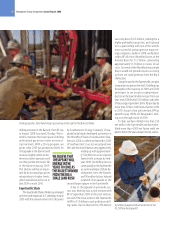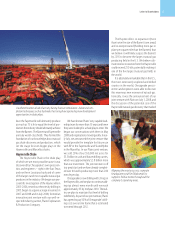Chesapeake Energy 2008 Annual Report Download - page 20
Download and view the complete annual report
Please find page 20 of the 2008 Chesapeake Energy annual report below. You can navigate through the pages in the report by either clicking on the pages listed below, or by using the keyword search tool below to find specific information within the annual report.
Investor Q&A
What dierentiates CHK from its
competitors?
At least four factors differentiate Ches-
apeake from its competitors: great people,
great assets, great strategy and great ex-
ecution. We recognized earlier than most
companies in the U.S. exploration and pro-
duction industry that the combination of
structurally higher natural gas prices and
better drilling and completion technologies
would make unconventional natural gas re-
source plays highly economic. We aggressively
invested in shale-focused leasehold and have
built the nation’s top natural gas resource
base. Our Powerful Assets include a #1 or
#2 position in the four most important shale
plays – the Barnett, Fayetteville, Haynesville
and Marcellus – which we refer to as the “Big
4.” No other company in the industry has this
distinction and competitive advantage in the
low-cost, low-risk Big 4 shale plays. Ches-
apeake now owns approximately 15 million
net acres of total leasehold in the U.S. and has
identified more than 36,000 drilling opportu-
nities on this leasehold. We believe this deep
backlog of drilling inventory – more than 10
years worth at current drilling levels – pro-
vides unusual confidence and transparency
in our future growth capabilities.
Chesapeake has also designed and built
a talented, technologically focused organi-
zation that skillfully executes the nation’s
largest drilling program. This organization
enables the company to quickly and efficient-
ly convert its investment in leasehold into
more valuable proved reserves and produc-
ing properties through a low-risk, vertically
integrated manufacturing approach to the
business.
How has shale gas changed
the energy industry?
We believe that the discovery and com-
mercialization of natural gas from shales have
transformed the U.S. exploration and produc-
tion industry as the finding and development
cost curve for the industry has rapidly and
dramatically shifted. Until about five years
ago, most companies in our industry had rel-
atively similar asset bases, and the cost for
the most efficient producers to add reserves
and production was not very different from
that of the least efficient producers. Over
the past few years, our industry has applied
better drilling and completion technology
to recover conventional resources on tight-
er spacing patterns. Combined with steadily
rising natural gas prices of the past few years,
the accelerated rate of production from con-
ventional resources created excellent returns
for companies and shareholders. However,
very few large new conventional natural gas
resources were actually found – existing re-
sources were simply produced faster.
However, shale plays have recently
achieved tremendous breakthroughs as
Chesapeake and the industry have applied
rapidly improving geoscience expertise and
engineering technologies to identify, drill
and produce natural gas from a handful of
prolific shale plays. While not all shale plays
are commercially viable, the best shale plays,
particularly the Big 4, offer the lowest find-
ing and development costs and best returns
in the industry. Even greater benefits are the
large scale of the shale plays and their pre-
dictable, low-risk performance.
The industry has been successful at in-
creasing reserve recoveries, reducing drilling
costs and generating high rates of return in
a manufacturing-like operation from shale
plays. As a result, our industry is becoming in-
creasingly divided between the “shale haves”
and the “shale have-nots.” We believe that
only 10 or so companies comprise the “shale
haves,” compared to about 10,000 “shale
have-nots,” and Chesapeake is the largest
beneficiary of this distinction in the indus-
try with a Top 2 position in each of the four
best shale plays in America. Conversely, the
thousands of other companies that missed
the Big 4 shale land rush of 2004 to 2008,
will likely be at a competitive disadvantage
for years, if not decades, to come.
More importantly, the prolific Big 4 shale
plays underpin a tremendous opportunity
for change in America’s energy and environ-
Punctuating the blue sky of West
Virginia, a Chesapeake-operated
Yost drilling rig drills 24/7 as the
company ramps up development
of the Marcellus Shale. On January
1, 2009, Chesapeake combined
the expertise and resources
of its Yost and Nomac drilling
subsidiaries into a consolidated
Nomac entity to better coordinate
drilling programs.
21
Operating Areas
22
Chesapeake Energy Corporation Annual Report 2008
Steven C. Dixon, Executive Vice President –
Operations and Chief Operating Ocer
Marcus C. Rowland, Executive Vice President
and Chief Financial Ocer
























